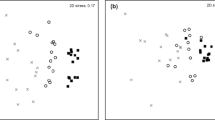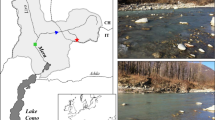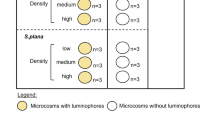Abstract
Patches of decomposing macroalgae can be beneficial to intertidal regions, providing habitat and food, or can create anoxic conditions inhospitable to benthic organisms. These opposing outcomes warrant further investigations into biotic-abiotic processes associated with macroalgae. Here, differences in surface sediment erosion measures (erosion threshold (Ʈc; N m−2), erosion rate (ER; g m−2 s−1), and sub-surface erosion rates (me; g N−1 s−1)) were examined at sites dominated by the suspension-feeding clam or deposit-feeding bivalve (Austrovenus stutchburyi and Macomona liliana, respectively) after 30 days of exposure to decomposing macroalgae (Ulva spp.). The Austrovenus site was chosen to represent a species-rich, functionally diverse macrofaunal community. The nearby Macomona site had similar sediment characteristics, yet had a less abundant and diverse faunal community. Despite the equal amounts of Ulva recovered from both sites (< 3% of the initial 3 kg wet weight m−2 added), differences in surface erosion were measured. One day after Ulva removal, an initial increase in surface erosion (−Ʈc and +ER) was measured at the Austrovenus site, but after 14 days there was no difference compared with control plots. At the Macomona site, Ulva addition stabilized sediments (+Ʈc and -ER), an effect that persisted for 14 days. These differences were reflected in the macrofaunal community. At the Austrovenus site, the macrofaunal community recovered within 14 days whereas differences between Ulva and controls persisted at the Macomona site. This work emphasizes how subtle differences in benthic community composition and recovery can result in spatial and temporal variations in sediment erosion potential on intertidal sandflats.




Similar content being viewed by others
References
Andersen TJ (2001) Seasonal variation in erodibility of two temperate, microtidal mudflats. Estuar Coast Shelf Sci 53:1–12
Andersen TJ, Pejrup M (2002) Biological mediation of the settling velocity of bed material eroded from an intertidal mudflat, the Danish Wadden Sea. Estuar Coast Shelf Sci 54:747–745
Andersen TJ, Lund-Hansen LC, Pejrup M, Jensen KT, Mouritsen KN (2005) Biologically induced differences in erodibility and aggregation of subtidal and intertidal sediments: a possible cause for seasonal changes in sediment deposition. J Mar Syst 55:123–138
Anderson MJ (2001) A new method for non-parametric multivariate analysis of variance. Austral Ecol 26:32–46
Anderson MJ, Gorley RN, Clarke KR (2008) PERMANOVAþ for PRIMER: Guide to software and statistical methods. PRIMER-E, Plymouth, UK.
Arar E, Collins G (1997) Method 445.0: in vitro determination of chlorophyll a and phaeophytin a in marine and freshwater algae by fluorescence revision 1.2. U.S. Environmental Protection Agency, Cincinnati, p 22
Balke T, Herman PMJ, Bouma TJ (2014) Critical transitions in disturbance-driven ecosystems: identifying windows of opportunity for recovery. J Ecol 102:700–708
Bolam SG, Fernandes TF, Read P, Raffaelli D (2000) Effects of macroalgal mats on intertidal sandflats: an experimental study. J Exp Mar Biol Ecol 249:123–137
Bonsdorff E (1992) Drifting algae and zoobenthos- effects on settling and community structure. J Sea Res 30:57–62
Busing P (1999) Impacts of inter-tidal macroalgal mats on benthic communities. MSc. University of Waikato, Hamilton
Canal-Vergés P, Vedel M, Valdemarsen, Kristensen E, Flindt (2010) Resuspension created by bedload transport of macroalgae: implications for ecosystem functioning. Hydrobiologia 649:69–76
Cardoso PG, Pardal MA, Raffaelli D, Baeta A, Marques JC (2004) Macroinvertebrate response to different species of macroalgal mats and the role of disturbance history. J Exp Mar Biol Ecol 308:207–220
Corzo A, van Bergeijk SA, García-Robledo E (2009) Effects of green macroalgal blooms on intertidal sediments: net metabolism and carbon and nitrogen contents. Mar Ecol Prog Ser 380:81–93
Dean W (1974) Determination of carbonate and organic matter in calcareous sediments and sedimentary rocks by loss on ignition: comparison with other methods. J Sediment Petrol 44:242–248
Dubois M, Gilles KA, Hamilton JK, Rebers PA, Smith F (1956) Colorimetric determination of sugars and related substances. Anal Chem 28:350–356
Duffy JE, Hay ME (2000) Strong impacts of grazing amphipods on the organization of a benthic community. Ecol Monogr 70:237–263
Everett RA (1994) Macroalgae in marine soft-sediment communities: effects on benthic infaunal assemblages. J Exp Mar Biol Ecol 175:253–274
Fagherazzi S, FitzGerald DM, Fulweiler RW, Hughes Z, Wiberg PL, McGlathery KJ, Morris JT, Tolhurst TJ, Deegan LA, Johnson DS (2013) Ecogeomorphology of tidal flats. In: Shroder J, Butler DR, Hupp CR (eds) Treatise on geomorphology, Ecogeomorphology, vol 12. Academic Press, San Diego, pp 201–220
Gamito S, Furtado R (2009) Feeding diversity in macroinvertebrate communities: a contribution to estimate the ecological status in shallow waters. Ecol Indic 9:1009–1019
Geertz-Hansen O, Sand-Jensen K, Hansen DF, Christiansen A (1993) Growth and grazing control of abundance of the marine macroalgae, Ulva Lactuca L. in a eutrophic Danish estuary. Aquat Bot 46:101–109
Gladstone-Gallagher RV, Lohrer AM, Lundquist CJ, Pilditch CA (2016) Effects of detrital subsidies on soft-sediment ecosystem function are transient and source-dependent. PLoS One 11:e0154790
Graf G, Rosenberg R (1997) Bioresuspension and biodeposition: a review. J Mar Syst 11:269–278
Greenfield BL, Kraan C, Pilditch CA, Thrush SF (2016) Mapping functional groups can provide insight into ecosystem functioning and potential resilience of intertidal sandflats. Mar Ecol Prog Ser 548:1–10
Greening L, Fong P (2016) The good, the bad and the Ulva: the density dependent role of macroalgal subsidies in influencing diversity and trophic structure of an estuarine community. Oikos 125:988–1000
Hansen K, Kristensen E (1997) Impact of macrofaunal recolonization on benthic metabolism and nutrient fluxes in shallow marine sediment previously overgrown with macroalgal mats. Estuar Coast Shelf Sci 45:613–628
Harris RJ, Pilditch CA, Hewitt JE, Lohrer AM, Van Colen C, Townsend M, Thrush SF (2015) Biotic interactions influence sediment erodibility on wave-exposed sandflats. Mar Ecol Prog Ser 523:15–30
Harris RJ, Pilditch CA, Greenfield BL, Moon VG, Kröncke I (2016) The influence of benthic macrofauna on the erodibility of intertidal sediments with varying mud content in three New Zealand estuaries. Estuar Coasts 39:815–828
Hicks DM, Hume TM (1996) Morphology and size of ebb tidal deltas at natural inlets on open-sea and pocket-bay coasts, North Island, New Zealand. J Coast Res 12:47–63
Hicks DM, Hume TM, Swales A, Green MO (1999) Magnitudes, spatial extent, time scales ad causes of shoreline change adjacent to an ebb tidal delta, Katikati Inlet, New Zealand. J Coast Res 15:220–240
Holmer M, Nielsen RM (2007) Effects of filamentous algal mats on sulfide invasion in eelgrass (Zostera marina). J Exp Mar Biol Ecol 353:245–252
Hull SC (1987) Macroalgal mats and species abundance: a field experiment. Estuar Coast Shelf Sci 25:519–532
Joensuu M, Pilditch CA, Harris RJ, Hietanen S, Pettersson H, Norkko A (2017) Sediment properties, biota and local habitat structure explain variation in the erodibility of coastal sediments. Limnol Oceanogr 63:173–186
Jones HFE, Pilditch CA, Bruesewitz DA, Lohrer AM (2011) Sedimentary environment influences the effect of an infaunal suspension feeding bivalve on estuarine ecosystem function. PLoS One 6:e27065
Karlson AML, Niemand C, Savage C, Pilditch C (2016) Density of key-species determines efficiency of macroalgae detritus uptake by benthic communities. PLoS One 1(7):e0158785
Klute A, Dirksen C (1986) Hydraulic conductivity and diffusivity: laboratory methods. Methods of soil analysis (part 1) physical and mineralogical methods. American Society of Agronomy, pp 687–700
Lapointe BE, Tenore KR (1981) Experimental outdoor studies with Ulva fasciata Delile. I. Interaction of light and nitrogen on nutrient uptake, growth, and biochemical composition. J Exp Mar Biol Ecol 53:135–152
Legendre P, Thrush SF, Cummings VJ, Dayton PK, Grant J, Hewitt JE, Hines AH, McArdle BH, Pridmore RD, Schneider DC, Turner SJ, Whitlatch RB, Wilkinson MR (1997) Spatial structure of bivalves in a sandflat: scale and generating processes. J Exp Mar Biol Ecol 216:99–128
Lelieveld SD, Pilditch CA, Green MO (2004) Effects of deposit-feeding bivalve (Macomona liliana) density on intertidal sediment stability. N Z J Mar Freshw Res 38:115–128
Liu D, Keesing JK, He P, Wang Z, Shi Y, Wang Y (2013) The world’s largest macroalgal bloom in the Yellow Sea, China: formation and implications. Estuar Coast Shelf Sci 129:2–10
Lumborg U, Andersen TJ, Pejrup M (2006) The effects of Hydrobia ulvae and microphytobenthos on cohesive sediment dynamics on an intertidal mudflat described by means of numerical modelling. Estuar Coast Shelf Sci 68:208–220
Marsden ID, Bressington MJ (2009) Effects of macroalgal mats and hypoxia on burrowing depth of the New Zealand cockle (Austrovenus stutchburyi). Estuar Coast Shelf Sci 81:438–444
Martins I, Pardal MA, Lillebø AI, Flindt, Marques JC (2001) Hydrodynamics as a major factor controlling the occurrence of green macroalgal blooms in a eutrophic estuary: a case study on the influence of precipitation and river management. Estuar Coast Shelf Sci 52:165–177
Montserrat F, Van Colen C, Degraer S, Ysebaert T, Herman PMJ (2008) Benthic community-mediated sediment dynamics. Mar Ecol Prog Ser 372:53–59
Morand P, Merceron M (2005) Macroalgal population and sustainability. J Coast Res 21:1009–1020
Nedergaard RI, Risgaard-Petersen N, Finster K (2002) The importance of sulfate reduction associated with Ulva lactuca thalli during decomposition: a mesocosm experiment. J Exp Mar Biol Ecol 275:15–29
Nordström M, Bonsdorff E, Salovius S (2006) The impact of infauna (Nereis diversicolor and Saduria entomon) on the redistribution and biomass of macroalgae on marine soft bottoms. J Exp Mar Biol Ecol 333:58–70
Norkko A, Bonsdorff E (1998a) Rapid zoobenthic community responses to accumulations of drifting algae. Mar Ecol Prog Ser 131:143–157
Norkko A, Bonsdorff E (1998b) Population responses of coastal zoobenthos to stress by drifting algal mats. Mar Ecol Prog Ser 140:141–151
Norkko J, Bonsdorff E, Norkko A (2000) Drifting algal mats as an alternative habitat for benthic invertebrates: species specific responses to a transient resource. J Exp Mar Biol Ecol 248:79–104
Nowell AR, Jumars PA (1984) Flow environments of aquatic benthos. Annu Rev Ecol Evol Syst 15:303–328
Nowell ARM, Jumars PA, Eckman JE (1981) Effects of biological activity on the entrainment of marine sediments. Mar Geol 42:133–153
Orr M, Zimmer M, Jelinski DE, Mews M (2005) Wrack deposition on different beach types: spatial and temporal variation in the pattern of subsidy. Ecology 86:1496–1507
Passarelli C, Olivier F, Paterson DM, Hubas C (2012) Impacts of biogenic structures on benthic assemblages: microbes, meiofauna, macrofauna and related ecosystem functions. Mar Ecol Prog Ser 465:85–97
Pratt DR, Pilditch CA, Lohrer AM, Thrush SF, Kraan C (2015) Spatial distributions of grazing activity and microphytobenthos reveal scale-dependent relationships across a sedimentary gradient. Estuar Coasts 38:722–734
Raffaelli DG, Raven JA, Poole LJ (1998) Ecological impacts of green macroalgal blooms. Oceanogr Mar Biol Annu Rev 36:97–125
Reise K (2002) Sediment mediated species interactions in coastal waters. J Sea Res 48:127–141
Rodil IF, Lohrer AM, Hewitt JE, Townsend M, Thrush SF, Carbines (2013) Tracking environmental stress gradients using three biotic integrity indices: advances of a locally-developed traits-based approach. Ecol Indic 34:560–570
Romano C, Widdows J, Brinsley MD, Staff FJ (2003) Impact of Enteromorpha intestinalis mats on near-bed currents and sediment dynamics: flume studies. Mar Ecol Prog Ser 256:63–74
Rossi F (2006) Small-scale burial of macroalgal detritus in marine sediments: effects of Ulva spp. on the spatial distribution of macrofauna assemblages. J Exp Mar Biol Ecol 332:84–95
Rossi F, Underwood AJ (2002) Small-scale disturbance and increased nutrients as influences on intertidal macrobenthic assemblages: experimental burial of wrack in different intertidal environments. Mar Ecol Prog Ser 241:29–39
Salovius S, Nyqvist M, Bonsdorff E (2005) Life in the fast lane: macrobenthos use temporary drifting algal habitats. J Sea Res 53:169–180
Sandwell DR, Pilditch CA, Lohrer AM (2009) Density dependent effects of an infaunal suspension-feeding bivalve (Austrovenus stutchburyi) on sandflat nutrient fluxes and microphytobenthic productivity. J Exp Mar Biol Ecol 373:16–25
Schünemann M, Kühl H (1991) A device for erosion measurement on naturally formed, muddy sediments: the EROMES system. Report of GKSS Research Centre GKSS 91/E/18, p 28
Sfriso A, Marcomini A (1997) Macrophyte production in a shallow coastal lagoon. Part I: coupling with chemico-physical parameters and nutrient concentrations in waters. Mar Environ Res 44:351–375
Sfriso A, Pavoni B, Marcomini A, Orio AA (1992) Macroalgae, nutrient cycles and pollutants in the lagoon of Venice. Estuaries 15:517–528
Sfriso A, Birkemeyer T, Ghetti PF (2001) Benthic macrofauna changes in areas of Venice lagoon populated by seagrass or seaweeds. Mar Environ Res 52:323–349
Tambroni N, da Silva JF, Duck RW, McLelland SJ, Venier C, Lansoni S (2016) Experimental investigation of the impact of macroalgal mats on the wave and current dynamics. Adv Water Resour 93:326–335
Teichberg M, Fox SE, Olsen YS, Valiela I, Martinettos P, Iribarnes O, Muto EY, Petti MAV, Corbisier TN, Soto-Jiménez M, Páez-osuna F, Castro P, Freitas H, Zitelli A, Cardinalett M, Tagliapietrass D (2010) Eutrophication and macroalgal blooms in temperate and tropical coastal waters: nutrient enrichment experiments with Ulva spp. Glob Chang Biol 16:2624–2637
Thrush SF, Whitlatch RB, Pridmore RD, Hewitt JE, Cummings VJ, Wilkinson MR (1996) Scale-dependent recolonization: the role of sediment stability in a dynamic sandflat habitat. Ecology 77:2472–2487
Thrush SF, Halliday J, Hewitt JE, Lohrer AM (2008) The effects of habitat loss, fragmentation, and community homogenization on resilience in estuaries. Ecol Appl 18:12–21
Underwood GJC, Paterson DM, Parkes RJ (1995) The measurement of microbial carbohydrate exopolymers from intertidal sediments. Limnol Oceanogr 40:1243–1253
Valiela I, McCelland J, Hauxwell J, Behr PJ, Hersh D, Foreman K (1997) Macroalgal blooms in shallow estuaries: controls and ecophysiological and ecosystem consequences. Limnol Oceanogr 42:1105–1118
Van Colen C, Montserrat F, Vincx M, Herman PMJ, Ysebaert T, Degraer S (2008) Macrobenthic recovery from hypoxia in an estuarine tidal mudflat. Mar Ecol Prog Ser 372:31–42
Vaquer-Sunyer R, Duarte CM (2010) Sulfide exposure accelerates hypoxia-driven mortality. 53:1075–1082
Verner C, da Silva JF, McLelland SJ, Duck RW, Lanzoni S (2012) Experimental investigation of the impact of macroalgal mats on flow dynamics and sediment stability in shallow tidal areas. Estuar Coast Shelf Sci 112:52–60
Volkenborn N, Meile C, Polerecky L, Pilditch CA, Norkko A, Norkko J, Hewitt JE, Thrush SF, Wethey DS, Woodin SA (2012) Intermittent bioirrigation and oxygen dynamics in permeable sediments: an experimental and modeling study of three Tellinid bivalves. J Mar Res 76:794–823
Wetzel MA, Weber A, Giere O (2002) Re-colonization of anoxic/sulfidic sediments by marine nematodes after experimental removal of macroalgal cover. Mar Biol 141:679–689
Widdows J, Brinsley MD, Salkeld PN, Elliot M (1998) Use of annular flumes to determine the influence of current velocity and bivalves on material flux at the sediment-water interface. Estuaries 21:552–559
Woodin SA, Wethey DS, Volkenborn N (2010) Infaunal hydraulic ecosystem engineers: cast of characters and impacts. Integr Comp Biol 50:176–187
Worm B, Lotze HK, Sommer U (2000) Coastal food web structure, carbon storage, and nitrogen retention regulated by consumer pressure and nutrient loading. Limnol Oceanogr 45:339–349
Acknowledgments
We thank Dudley Bell, Rebecca Gladstone-Gallagher, and Daniel Pratt, for field assistance; Barry Greenfield and Sarah Hailes for their expertise in macrofaunal identification; Rolf Riethmüller for assistance constructing the EROMES and Niels Volkenborn for assistance in developing a hydraulic conductivity measurement device; Michael Townsend for internal review; and two anonymous reviewers for their helpful comments.
Funding
This research was funded by a University of Waikato International Doctoral Scholarship awarded to R.J.H. and a University of Waikato Doctoral Scholarship awarded to C.N. as part of INTERCOAST, a joint research program between the Universities of Waikato and Bremen.
Author information
Authors and Affiliations
Corresponding author
Additional information
Publisher’s note
Springer Nature remains neutral with regard to jurisdictional claims in published maps and institutional affiliations.
Rights and permissions
About this article
Cite this article
Harris, R.J., Niemand, C. & Pilditch, C.A. Decomposing macroalgae (Ulva spp.) impacts benthic macrofauna and surface sediment erosion. Geo-Mar Lett 40, 281–294 (2020). https://doi.org/10.1007/s00367-019-00593-z
Received:
Accepted:
Published:
Issue Date:
DOI: https://doi.org/10.1007/s00367-019-00593-z




